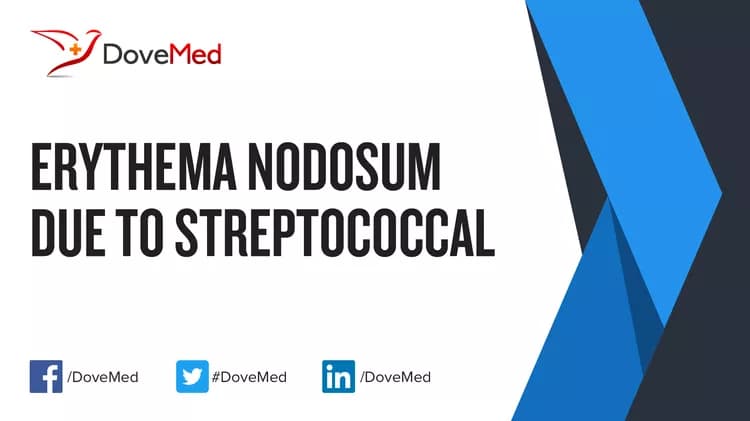What are the other Names for this Condition? (Also known as/Synonyms)
- Streptococcal Infection-Associated Erythema Nodosum
What is Erythema Nodosum due to Streptococcal Infection? (Definition/Background Information)
- Erythema nodosum is a skin condition that causes painful red subcutaneous nodules. It may be caused by numerous factors including certain medications, infectious diseases, pregnancy, inflammatory bowel disease, blood cancer, and many other disorders
- Erythema Nodosum due to Streptococcal Infection occurs against a background of an infection caused by the bacteria Streptococcus (group A and group B). Based on the type of bacteria, streptococcal infections may involve the throat, skin, lungs, or the brain
- The nodules in Erythema Nodosum due to Streptococcal Infection may occur on the legs and arms. The signs and symptoms of streptococcal infection depend on whether it is caused by group A or group B Streptococcus bacterium
- Adequate treatment of the underlying infection using antibiotic therapy can help resolve Erythema Nodosum due to Streptococcal Infection. With appropriate early treatment, the prognosis of erythema nodosum is good in a majority of individuals
Who gets Erythema Nodosum due to Streptococcal Infection? (Age and Sex Distribution)
- Erythema Nodosum due to Streptococcal Infection may occur at any age; both children and adults can be affected
- Both males and females are affected
- It can affect individuals of any ethnicity, race or region
What are the Risk Factors for Erythema Nodosum due to Streptococcal Infection? (Predisposing Factors)
- Individuals, with any type of streptococcal infection, are at an increased risk for developing Streptococcal Infection-Associated Erythema Nodosum
It is important to note that having a risk factor does not mean that one will get the condition. A risk factor increases one’s chances of getting a condition compared to an individual without the risk factors. Some risk factors are more important than others.
Also, not having a risk factor does not mean that an individual will not get the condition. It is always important to discuss the effect of risk factors with your healthcare provider.
What are the Causes of Erythema Nodosum due to Streptococcal Infection? (Etiology)
- Research scientists believe that Erythema Nodosum due to Streptococcal Infection is caused by an immunological response of the body to streptococcal infection. The nodules form on skin as a reaction to the underlying condition
- Streptococcal infections constitute a wide variety of bacterial infections caused by either group A Streptococcus or group B Streptococcus. Such infections include:
- Bacteremia
- Cellulitis
- Perianal cellulitis
- Impetigo
- Meningitis
- Pneumonia
- Scarlet fever
- Strep throat
- Toxic shock syndrome
- Urinary tract infection
- These infections spread through the inhalation of infected particles, direct physical contact, discharge from infected individuals, or even from an infected mother to her unborn child
Erythema nodosum can occur in a background of rheumatic fever caused by group A Streptococcus. Rheumatic fever consists of fever, fatigue, joint aches, and rapid heart rates. The presence of erythema nodosum should prompt the healthcare provider to look for symptoms of rheumatic fever, which can potentially cause serious heart damage.
What are the Signs and Symptoms of Erythema Nodosum due to Streptococcal Infection?
The signs and symptoms of Erythema Nodosum due to Streptococcal Infection may include:
- Presence of nodules beneath the skin
- They begin as flat, firm, red lumps measuring up to an inch
- After a few days, the nodules turn deep red to purple; weeks later, they become flat and brownish patches
- The symptoms of streptococcal infection depend on the specific type of illness and the region/body part affected
- The nodules may be present on any part of the body, but are mostly observed on the legs, thighs, and buttocks
How is Erythema Nodosum due to Streptococcal Infection Diagnosed?
The following procedures may be used to diagnose Erythema Nodosum due to Streptococcal Infection:
- Thorough evaluation of the individual’s medical history and a complete physical examination
- Culture of body fluids or blood, to identify the streptococcal bacteria causing infection
- Imaging studies, such as X-rays and CT scans, as necessary
- Tissue biopsy, if necessary: A skin/tissue biopsy is performed and sent to a laboratory for a pathological examination. The pathologist examines the biopsy under a microscope. After putting together clinical findings, special studies on tissues (if needed) and with microscope findings, the pathologist arrives at a definitive diagnosis
Many clinical conditions may have similar signs and symptoms. Your healthcare provider may perform additional tests to rule out other clinical conditions to arrive at a definitive diagnosis.
What are the possible Complications of Erythema Nodosum due to Streptococcal Infection?
- Major complications associated with skin lesions of Erythema Nodosum due to Streptococcal Infection are generally not reported
- However, complications are mostly observed due to the underlying streptococcal infection
- Severe infection may be observed in individuals with poor immune function
How is Erythema Nodosum due to Streptococcal Infection Treated?
The treatment options of Erythema Nodosum due to Streptococcal Infection include treating the underlying bacterial infection, which is undertaken through:
- Administration of antibiotics
- Symptomatic and supportive therapy, as needed
On treating the underlying condition, erythema nodosum skin lesions usually disappears.
How can Erythema Nodosum due to Streptococcal Infection be Prevented?
The prevention of Erythema Nodosum due to Streptococcal Infection is linked to preventing the associated streptococcal infection, which may be enabled through the following measures:
- Undertaking early diagnosis and treatment of streptococcal infection, especially in individuals with poor immune function, infants, and elderly adults
- Avoiding physical contact with infected individuals
- Practicing regular hand wash and personal hygiene
- Getting treatment for any underlying medical condition(s) that may decrease immunity in the individual
What is the Prognosis of Erythema Nodosum due to Streptococcal Infection? (Outcomes/Resolutions)
- The prognosis for Erythema Nodosum due to Streptococcal Infection is usually good with prompt treatment of group A or group B streptococcal infection
- However, the overall prognosis is dependent on the underlying infection, the severity of the symptoms presented, and the health status of the individual
Additional and Relevant Useful Information for Erythema Nodosum due to Streptococcal Infection:
- Cleaning the skin too hard with strong chemicals or soaps may aggravate the skin condition. Care must be taken avoid strong soaps and chemicals that could potentially worsen the condition
- The presence of dirt on the body is not a causative factor for the condition. However, it helps to be clean and hygienic, which may help the condition from getting worse
Related Articles
Test Your Knowledge
Asked by users
Related Centers
Related Specialties
Related Physicians
Related Procedures
Related Resources
Join DoveHubs
and connect with fellow professionals



0 Comments
Please log in to post a comment.